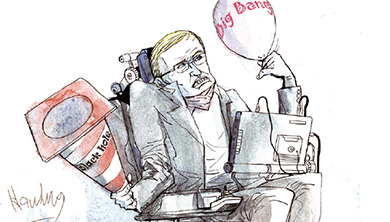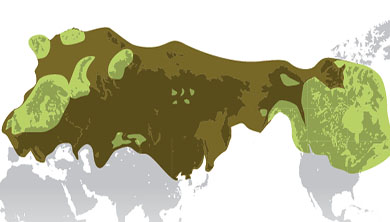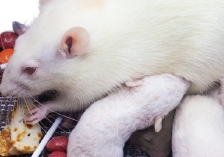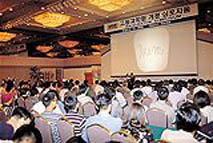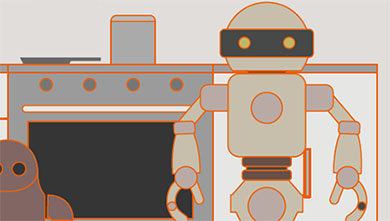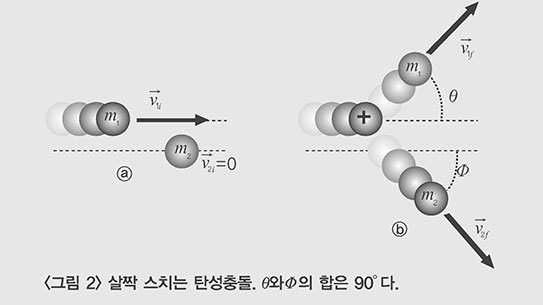잘 아는 바와 같이 남편과 아내는 함께 협동하며 살아간다. 협동이란 인간이 아닌 다른 생물의 세계에 있어서도 매우 중요한 낱말이 되는데 이는 협동하며 사는 무리들이 많을 뿐 아니라 흥미로운 사례들이 오늘도 새로이 발견되며 연구되고 있기 때문이다.
모든 다세포 생물들이 존재하는 것은 세포들의 협동 덕택이다. 세포차원에서의 협동은 가끔씩은 지극히도 이타주의적인 것처럼 보인다. 흔히 정자들은 독립성이 강하고 경쟁적이라고 생각되지만 쥐의 정자들은(가장 먼저 난자와 수정하도록 노력함에 있어서) 사실 같은 무리속의 훼손된 정자들의 협조를 얻어 이 목적을 달성하게 된다. 정상적인 정자 하나가 성공적인 수정에 임할 때 불구의 정자들이 서로 엉겨붙어 마개를 형성함으로써 다른 정자들이 생식기관으로 돌입하는 것을 예방하는 것이다.
어떤 박테리아들은 협동하며 먹이를 사냥하고 침략을 일삼기도 한다. 또 다른 박테리아는 오래전 파괴가 아닌 서로의 이익을 위해 살아있는 세포속으로 침입했다. 이 박테리아는 세포에 있어 매우 중요한 미토콘드리아가 됐다. 우리는 인간 나름대로의 미토콘드리아가 없이는 살지 못한다.
진화를 추진하는 원동력이 이기주의라는 명제가 꼭 맞지는 않는 것 같다. 이타주의적이라든가 협동한다는 것은 개별적으로는 희생되더라도 생물의 종이 살아남도록 보증하는 대단한 장점을 부여한다. 이와같은 현상은 흰개미 벌 말벌 개미 등 무리지어 사는 곤충들의 세계에서 극적으로 잘 나타나고 있다. 이처럼 복잡한 세계에서의 어떤 구성원들은 스스로 번식하지 못하고 오로지 같은 종류의 남들만을 돕고자 일하기도 한다.
예를들어 유전적 특성들은 벌들속에 이타심을 심어주었다. 새끼를 못 낳는 암펄은 그렇게 태어난 것에 어쩔 수 없을 뿐 아니라 그 사실 자체를 생각하지도 않은채 자연적으로 새끼를 낳는 자매들을 돕느라 열심이다. 협동이란 부모의 새끼들에 대한 헌신으로부터 시작해 그 새끼들이 나중엔 부모와 자신의 새끼들을 먹여살리는 과정으로 이어진다.
아프리카의 털없는 두더지는 설치(楔齒)동물중 히스트리코그나디계에 속한다(기니피그와 호저도 여기에 포함된다). 이 두더지는 진짜 쥐의 털없는 새끼처럼 보이지만 우리 인간이 흔히 털이 보송보송한 어린 고양이나 강아지를 볼 때 터뜨리는 "어머나, 정말 귀엽게 생겼네" 식의 반응은 불러 일으키지 않는다(우리들의 아기는 머리부터 발끝까지 털이라곤 전혀 없는데도 말이다).
그러나 이 털없는 두더지는 포유동물임에도 무리지어 사는 곤충과 다름없어 매우 흥미롭다. 그들에겐 새끼를 낳는 한마리의 여왕이 있고 이타심이 강한 다른 두더지들은 그 여왕을 돌보며 땅밑 거대한 영토에서의 생활이 지속되도록 열심히 노동한다. 이들의 복잡한 사회상은 고작 몇년전 제니퍼 자비스에 의해 처음으로 소개됐으며 현재는 집중적연 연구의 대상이 되고 있다.
우리 인간은 비이기주의적이고 협동심이 강해서 성공한 경우에 대해 대단한 호기심을 보인다.
원시인들은 늑대를 길들여 인간을 자신이 속한 무리의 지도자로 여기는 충성스러운 개로 변화시켰다. 이것이 가능했던 이유는 인간과 늑대 둘다 사냥을 할 줄 알았고 또한 협동하며 사는 법을 알았기 때문이다. 사람처럼 늑대새끼들도 무리지어 사는 떼의 구성원이어야 하도록 유전적으로는 계획되지 않았지만 오래지 않아 사회의 일원으로 살아가는 법을 배워나간다. 사람에 의해 길러진 새끼는 사람을 같은 '무리'로 여기고 지도자로 섬기는데 이는 물론 우리에게 여러가지 혜택을 제공한다. 서구의 목장주인들은 이러한 현상을 유익하게 이용하기 위해 강아지들을 양과 함께 길렀다. 개들은 자신들이 양과 같은 가족이라고 생각하며 그들을 보호했던 것이다.
우리의 가장 가까운 친척인 침팬지와 고릴라 역시 협동하며 살아간다. 침팬지들은 서로 싸운 후에는 평화를 유지하기 위해 '키스로 화해'한다. 밀림속의 침팬지들은 최근 단체로 협동하며 사냥하는 모습도 발견됐는데 이는 우리의 조상들이 취했을 것으로 보이는 행동과 아주 유사한 방법이다. 밀림속 침팬지들은 다른 침팬지들보다 고기를 함께 나누어먹는 경향이 있는데 원시인들은 바로 이와 같은 이타심으로 발전했을 가능성이 높다.
제인 구달의 연구는 침팬지가 다른 침팬지들과 오랫동안 인연을 맺고 친밀한 관계로 지내는 경우보다 오래 살아감을 보여주고 있다. 어느 엄마 침팬지는 아주 오래 살았는데 그것은 아들이 돌보아준 덕분이었다. 엄마 침팬지가 죽자 그 아들도 슬픔에 빠져 죽고 말았다. 정말 우리의 가까운 사촌임이 분명하다.
인간은 탁월할 정도로 협동하며 살아가는 생명체들이다. 뉴욕 맨하탄의 고층건물에서 창밖을 바라보노라면 저밑 길위에서 있음직한 못된 인간들의 행동에도 불구하고 서로간의 협동 없이는 이와같은 도시가 건설될 수 없었으리라는 생각을 감출 수가 없다.
스탠퍼드 대학의 고고학자인 존 릭이 최근 수집한 증거에 의하면 석기시대의 페루사람들은 우리가 원시인들이 어떻게 살았으리라고 생각하는 것보다는 더욱 환경을 보존하며 살았던 것으로 보인다. 그들이 번식하는 동물들을 보존하기 위해 어린 새끼들을 죽이는 일을 피하려고 노력했음은 분명해 보인다. 또한 유아들을 살해하는 방법에 의존하지 않으려고 어쩌면 청소년들을 다른 곳으로 가 있도록 명령하거나 절제있는 성생활을 통해 자신들의 자손번식속도가 안정되도록 했다. 이 페루사람들은 요즘은 잘 찾아보기 힘든 협동심의 조화속에서 살았던 것처럼 보인다.
국가들이 서로 다투거나 파벌전쟁으로 분열되고 정당끼리 싸움을 벌이며 특히 큰 선거가 있는 해가 되어 같은 서열끼리도 논쟁을 할 때면 인류를 협동하는 동물로 생각하기가 어려워진다. 그러나 인간이 사회적으로 협동하며 살아가는 동물이고 생물학적으로 협동하며 움직이는 지구의 일부분임에는 분명하다. 우리가 서로 협동하지 않을 때 그 결과는 잔인할 것이며 우리는 그 사실을 쉽게 깨달을 수 있을 것이다. 자연의 섭리를 받아들이지 못하고 있다는 점은 정말 안타까운 일이다.
Cooperation
Husbandns and wives cooperate-and collaborate, as you can see. Cooperation is an important word for the rest of the living World, too, for there's a lot of it around, with interesting examples being discovered and examined every day.
All multicellular creatures exist thanks to the cooperation of their component cells. Sometimes cooperation on the cellular level can seem amazingly altruistic. While sperm are ordinarily thought of as independent and competing, it's been found that a normal rat sperm(trying to be first to impregnate the egg) is aided in its purpose by other, usually deformed sperm in the same batch. When the normal sperm is on its way to successful impregnation, the deformed sperm clump together to form a plug that prevents other sperm from entering the reproductive tract.
Certain bacteria apparently cooperate to hunt and attack prey. Other bacteria, very long ago, entered living cells not to destroy them, but to cooperate for mutual benefit. These bacteria became the mitochondria, essential parts of cells. We could not live without our own mitochondria.
It seems that self-interest, once thought to be the driving force behind evolution, is not necessarily the norm. Being altruistic and cooperative has enormous advantages, ensuring that the species will survive even if the individual does not. This is most dramatically seen in the social insects-termites, bees, wasps and ants. Some members of these complex societies never reproduce, but work to help others of their kind.
Genetics builds altruism into the bee, for instance. A female, but sterile worker bee can't help being born that way, and without thinking about it automatically strives to help gene-related sisters. In other animals, cooperation begins with the devotion of parents to offspring, some of whom stick around to help feed those parents and their own new siblings.
The African naked mole-rat belongs to the family Bathyergidae, suborder Hystricognathi(which also includes guinea pigs and porcupines). They look like the mostly hairless babies of real rats, and do not inspire the "ooh, aren't they cute" reaction that human beings usually have toward furry babies like kittens and puppies (even if our own babies are totally hairless from the head down.)
Naked mole-rats are nevertheless fascinating, for they are the mammalian equivalent of social insects. They have one queen who reproduces, and altruistic workers who tend her and keep the larger underground colony going. Their complex society was first described only a few years ago by Jennifer U.M. Jarvis, and is now under intensive study.
We humans seem to be intrigued by selflessness and cooperation that really works.
Primitive humans tamed the wolf and turned it into a helpful dog that considers a human his pack leader. This was possible because both the human and the wolf knew how to hunt and live cooperatively. Like humans, wolf pups are not genetically programmed into being part of a social group, but they soon learn. A pup raised by humans considers them to be his "pack" and obeys the pack leader - all to our advantage. Ranchers in the West have been advantageously using this aspect of dogdom by raising puppies with sheep. The puppies grow up thinking of the sheep as their family, which they defend.
Our closest relatives, the chimpanzees and gorillas, also live cooperatively. Fighting chimpanzees will "kiss and make up" aferward to keep the peace. Forest chimpanzees have recently been seen hunting in large cooperative groups, much the way it's thought our hominid ancestors behaved. The forest chimps are more inclined to share meat than other chimps, and it's probable that early hominid survival was improved by such altruism.
Jane Goodall's work with chimpanzees shows that individuals survive longer when they form close, long-term bonds with others. One chimpanzee mother lived into old age because her son cared for her. Unfortunately, when she died, he apparently died of grief. Close cousins to us, indeed.
Human beings are social creatures par excellence. It's not possible to gaze out of a window onto the towers of Manhattan without admitting that nothing like that could have been built without cooperation, regardless of the nasty human behavior that might be going on in the streets below.
Recent evidence gathered by Stanford archeologist John Rick indicates that Stone Age Peruvians lived more ecologically than primitives have been thought to do. To preserve breeding populations, they apparently tried to avoid killing young animals. They kept their own population stable without resorting to infanticide - probably by telling young adults to go elsewhere, and through sexual abstinence. They seemed to have lived in cooperative harmony not often known nowadays.
As nation-states bicker with each other or break up into dickering splinters, and as political parties fight with one another and -especially in a big election year - within their own ranks, it's hard to view humanity as a cooperative animal. But human beings ARE socially cooperative, very much part of a biologically cooperative planet Earth. When we aren't cooperative, the results are grim and easy to see. It's a pity we can't accept our true nature.
이 기사의 내용이 궁금하신가요?
기사 전문을 보시려면500(500원)이 필요합니다.
1992년 05월 과학동아 정보
🎓️ 진로 추천
- 생명과학·생명공학
- 사회학
- 문화인류학







